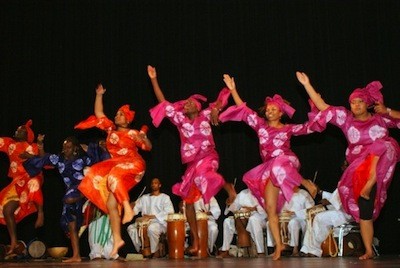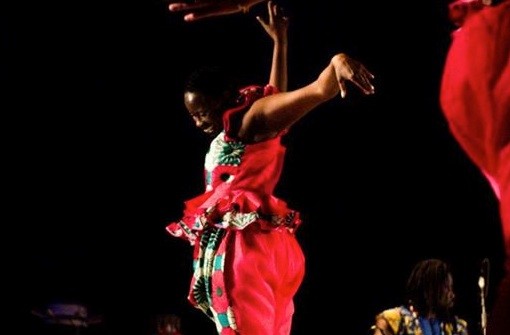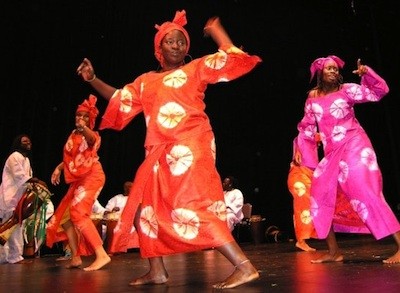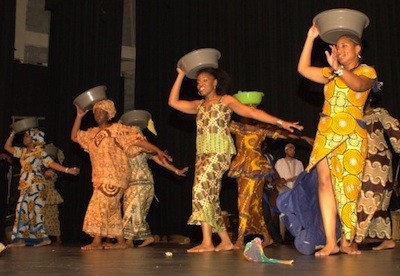On an August evening on the second floor of the Fitness Works gymnasium in Detroit’s New Center, a dance class is in full swing as six women step up a storm. They make sweeping movements with their arms, wheeling them backward. Each dancer’s upper body falls and rises, then they swivel their hands palm-up and move them up their bodies as though preening, then thrust them out again. Soon, they’re leaping up with one leg after another, landing with a double thump that you can feel shake the floor. Two drummers bang out live accompaniment, filling the air with lively percussion while the women keep moving, singing, clapping, stepping proudly. They point their arms and arch their backs exultantly. These ladies aren’t doing the minuet. It looks not just energetic, but absolutely athletic, a demanding workout, even if it is dance.
It’s African Dance class, and throughout it all, co-instructor Fatou-Seydi Sarr, is keeping time with her feet, watching her dancers in the mirror, or rushing around the room clapping and shouting to offer motivation and raise the energy level. With good reason too: The dancers have to be ready for an ambitious show just six weeks away. Much of her advice is nonverbal, as she pauses with dancers to show which move to alter, or which to accentuate to bring the troupe into agreement. Sometimes she directs one of the women to tighten up the jumps, to lift her legs higher, or to loosen stiff movements. And then there’s just the inspiration of watching her go: The native Senegalese cuts a striking pose as a dancer, overflowing with energy, muscular and limber, with an aggressive style that’s elegant in its economy of movement.
Sarr, known as “Seydi” to her friends, would never have guessed 20 years ago she’d be teaching African dance in Detroit. And yet it’s the culmination of a journey that has taken her halfway around the world, and, culturally speaking, full-circle.
How that happened is a remarkable story Sarr is happy to tell one late-summer afternoon at her home on Detroit’s west side, curled up on a couch. She looks much younger than she is — as she puts it with a deadpan smile: “I was made in 1975 — 40 years of being awesome.”
She begins her story in her native accent, which she wouldn’t part with anymore than one of the six languages she knows: Serer, Wolof, French, English, Japanese, and German. She adds, “And don’t talk about me in Spanish — I’ll catch you. I may not be able to say something back to you, but my ear is trained.”
Sarr comes from a prominent family in her native Senegal. She says, “My dad was a colonel in the Army. My mom’s uncle was the first president of Senegal. But we didn’t grow up like we were from a prominent family because, traditionally, in my tribe there is no caste system.”
Specifically, Sarr is from Niodior, an island off the coast of the western African country. Ethnically, she’s of the Serer-Niominka, a group of fisherfolk who have a long and storied history distinct from western Senegal’s Wolof-speaking peoples. Not having a caste system is just one part of their unusual heritage. As a fishing people, their nautical skills are such that some historians credit them with fighting off Portuguese slavers in their canoes more than five centuries ago.
Sarr was also born in the waning days of ethnic traditions that forbade her from performing “drum and dance.” She says, “When I started teaching, I had to let people know that I’m not a traditional griot — I don’t come from a family that is supposed to drum and dance. … In a lot of African tradition, things are divided. So in Senegal you have what you call the griot, and the griot caste is the one that usually does the dancing and the singing.”
Note well that a griot is not a dancer the way Westerners might understand it. A griot is more like a bard: Somebody who takes the events of the day and transforms them into art. As ethnomusicologist and Fulbright scholar Doris Green points out, many African languages don’t even have a word for dance; it was Western colonizers who called these rituals “dance,” believing that “movement to music was called dance in their societies, so it must be the same for African movement to music.” More accurately, drum and dance are often rituals that express community experiences. Green tells us, “The standard lifetime activities of birth, death, puberty, initiation, circumcision, naming ceremonies, and rites of passage … all have established routine dances for these events of life.”
Sarr says that times have changed. She notes that the griot caste still exists in Senegal, “but a lot of things have changed because you have a lot of them now who are in the popular culture and sing and dance popularly. … Today with the pop culture, whoever wants to dance can do it. It’s not about the big traditional values like it was before; it’s about making money, because now it’s a form of art like everywhere else in pop culture.”
But it wasn’t always that way. “I was not born from a Griot family, no,” Sarr says. “You’re not supposed to sing and drum and dance. But you’d be surprised.”
She adds, “My family is full of surprises.”
Of her unusual kin, Sarr says, “My family is full of what you would call ‘outliers,’ because we did not really follow the written path. My mom has eight children, and every single one of them is endowed with some type of artistic gift — to the heartache of my father and my mom for a long time. At the end, they just submitted to it.”
You see, Sarr was born into a family that claims its roots in the ruling hierarchy of her ethnic group, a fact that pretty much prohibited her from dancing as a performer. If it sounds unfair, Sarr points out that “societies in Africa were organized around trade, and each family had its role and stuck to it, transmitting knowledge from father to son, mother to daughter.” It worked for centuries, but as pop culture has gained currency in Senegal, it has presented something of a generation gap for Sarr, her siblings, and their parents.
Sarr laughs and says, “My mom came here in ‘04, when I just moved. At the time I had just started taking dance classes, and it was the funniest thing ever. I took her to dance class, and my mom would just sit in dance class, and she wouldn’t move. And all these girls were like, ‘Why isn’t she dancing?’ They would try to make her clap. And she would just be like, ‘No.’ They were like, ‘What’s wrong with your mom? Does she know how to dance?’ I told them, ‘She knows how to dance. She just doesn’t dance.’ It was so funny because some people got offended because they were like, ‘Does she think she’s better than us?’ It’s not the same culture. It’s not the same values. She’s from the old generation.”
Sarr says her long-suffering mother with the artistic children doesn’t even like to admit that her kids are artistic, though Sarr dances and all her seven siblings are either recording artists, authors, visual artists, or graphic designers.
“It took her a while, Sadie says. “If you ask her what her daughter is doing in America, she says, ‘Oh she’s going to school.’ And I’m teaching dance, too. And she says, ‘But you’re going to school.’ Fine, whatever. After a while, she was like, ‘Oh, she’s dancing. Seydi’s crazy.’ But I understood totally. We aren’t from the same generation. We weren’t raised the same way at all. She grew up in the village; I did not. For me, it was just funny because you can really look at the generation gap and know this is not the same Africa. We are not the same. We represent two faces, totally different. It’s beautiful, I think, when you look at it like: ‘This is where we were, and this is where we are today.’ Me and her are totally two faces. Two faces of Africa.”
When Sarr went to university at 19, she went to France to study language and culture at Université d’Orleans, then chose to go on to Paris to study business administration at Centre Européen de Formation Professionnelle starting in 1999. During her years as a student in the City of Light, she met her future husband, a Detroiter visiting friends in Paris.
“I met him in France in ’01,” she says. “We dated for three years, then it was, ‘OK, what are we going to do?’ He said, ‘I don’t speak French. I can’t find a job in France. You speak English. You move to America.’ And that was it.”
With that decision, Sarr moved from Paris to Detroit to study and live with her husband. She says, “I’m glad that I never had an illusion of what America was. … When I came here, I was shocked that Detroit was not a city like Paris was. There was no café outside, nobody walking down the street — that was a crazy thing to me. … I was sitting in front of the window all day and counting how many people would walk by my window, and I was like, ‘What is going on?’ I didn’t know how to drive, either. … And Campus Martius! I love Campus Martius today. Campus Martius ’03? There was nothing! It was a roundabout. It would echo.”
“I thought, ‘This is America?’ Why do people wanna come here? Why?”
At almost 30 years old, living 4,000 miles away from Senegal with her new husband, Sarr still hadn’t gotten into dance. She says, “I came to dance in a very unconventional way. I was at home, bored as can be. And my husband at the time had a gym subscription, so he said, ‘Go to the gym!’ So I went to the gym.”
Sarr saw an African dance class on the schedule, but dismissed the idea for weeks before finally wandering in at the end of one class. Finally, she says, “I was so bored. I thought, ‘Let me just go and check out what they’re doing over there,” ironically adding, “‘I am dying to see American people teaching African dance.’”
She says, “I walked into class and the lady was teaching, and I was like, ‘Huh? This is definitely not from Senegal, but it’s African dance. I can’t deny it.’ So I took the class. At the end of the class I’m walking out, and the instructor was like, ‘Hey, you!’ I kept walking. And she’s like, ‘Hey, yo! Deg nga Wolof?’ which means ‘Do you speak Wolof?’ And I was like, ‘Yes?’ ‘Then why were you not answering?’ ‘Well, why were you speaking Wolof?’”
That teacher was Crettia Hunter, whom Sarr learned had already been to Senegal 10 times in her life. Sarr says, “She was African-American, teaching African dance. She was like, ‘What are you doing here?’ ‘I just got married, my husband’s here.’ ‘Do you have family here?’ I was like, ‘No.’ And she was like, ‘Huh? Oh, you have to come home.’ So she took me to her house, introduced me to her family, and the following week she was like, ‘Do you want to go take classes?’ ‘Well, why not?’”
African dance quickly became a vortex that sucked her in. She says, “It was like American people say: ‘I drank the Kool-Aid.’”
Soon, Sarr was attending dance classes at the William Walker Center, and was somewhat out of her depth at first. She says, “I was so mad because I came to class, and I was dancing like somebody that has two left feet, like a duck in the classroom. I was so upset at the end of the class. It was like, ‘Oh, she’s from Africa?’”
“It was the first time I had to think of myself as an African,” Sarr says. “Because, you know, I’m Senegalese. I identify with my ethnic group, and I’m Serer. But there, talking about African dance. … I wasn’t bored anymore. It was a discovery. It was almost like, ‘Ooh, I have all this knowledge that was latent, lying inside of me, but it didn’t make sense. Especially when I started doing Senegalese dances — it’s like everything that they ever told you when you were growing up and didn’t explain to you. Now that you’re taking dance classes it makes sense to you. Small stuff, cultural stuff — you ask why when you’re young, and the answer is, ‘Because I said so.’ Now those ‘because I said so’s are making sense, and African dance was like piecing all that stuff — everything that I ever read, that I heard in a story, what I learned in history class, geography, who is who. … It was like, oh my god, fireworks. I drank the Kool-Aid, but I felt good. It was not poison. Now I can understand the history of my people better. Now I look at the relationship we have as different Africans who went through colonization, independence wars, and where we are today and how we relate to each other.”
Sarr grew dogged about studying African dance, and soon found a foothold for artistic expression. She says, “At the time I could take five to seven classes a week in Detroit, and I took every single one of them. The Walker Center, the gym here. Next thing you know, I’m on the road with Crettia Hunter going to an African dance conference. Going all over the Midwest — Columbus, Cincinnati, Cleveland, Chicago — then New York. My life just shifted around where African dance classes were happening, who was having a conference, who was teaching a workshop, who is coming where, which teacher is where.”
Dance instructor Hunter joined Sarr on a visit to her native village in 2007, and upon their return they co-founded the Rowe Niodior African Dance Company. Sarr says, “We were interested in how we could keep the traditions but build this space where people can meet, exchange, grow, and come back. And that’s what we’re trying to do. Whether you were born in America as an African-American, or whether you were born somewhere else, today we face the same issues across the globe. We’re getting into this global vent and everybody’s vacuumed in it.”
The explosion of global pop culture and its effects on native traditions strike close to home for Sarr, who has come to appreciate her native culture as a global traveler in the culturally polarized United States. She says, “It was the funniest thing, because I’m so far away from home. But then I thank my parents because I grew up in Senegal, but my father and my mom made sure we spoke our ethnic group languages, which is Serer. There are a lot of Serer who don’t speak Serer. They speak Wolof, which is the trade language in all of Senegal. We spoke Serer at home — my dad didn’t allow us to do anything but that. Holidays, he would ship us to the village because he was like, ‘I’m not gonna raise children who don’t know who they are.’ I’m thankful. I know that it made a big difference. When I came to America, the dynamic of the society here made me appreciate more the fact that I was rooted into my own culture first. This is a country where you have to take a stand for something. You gotta be white or black, Democrat or Republican. They shake you a little bit and they see how you’re rooted. They may not agree, but they give you respect.”
By day, Sarr does social work as a support coordinator for a neighborhood service organization, working with children. “It’s what I would call clinical social work, which was not my first love, but I love it because I learn a lot. I think that population has taught me so much. I have seen so much strength in the families.”
But after work and on weekends, when she isn’t busy raising her 10-year-old daughter, Sarr still leaps enthusiastically into Detroit’s African dance community. For her, dance is about more than cultural identity and artistic expression. It became a pathway into Detroit’s art community, and it’s somewhere she loves to be. She says, “Even after I divorced my husband, everybody was like, ‘Oh, she’s gonna go back to France.’ But I was in school at the time, and I was like, ‘Man, if I can make it until I get tired of it, then I’ll go.’ And I’m still here.”
Listen to Sarr talk about dance, you’d think she was talking about yoga or meditation or something transcendent. And the truth of it is that she is.
She says, “When you dance, you look at the person next to you and smile. Once you hit that chord and everybody hits it at the same time, it creates this energy and everybody’s riding the same vibe. Saturday classes are like, oh my god … everybody’s on the same vibration. We know that we are all connected. If somebody else moves differently, you will see people shift their body — like, ‘What did she just do?’ They didn’t hear it, but the vibration just let them know. If somebody has a funky attitude, you pick it up. You pick it up because everyone’s vibrating and they’re like, ‘Oh, this doesn’t belong.’ And you know.”
She clarifies the point, saying, “We lost that in our individual world — the iPhone, iPad, all that stuff. It’s good to be able, once a week, to kind of shift things back a little bit and keep this humanity going, knowing that, at the end of the day, we’re just in the same circle of life. I tell people when they come to my class: ‘This is the time to disconnect from your rationality.’ We live in a world where we think everything through. Sometimes you need to shut your mind and let your body take over. When we walk, we don’t think about the mechanics of walking. Walking is a whole process: Your brain is sending out all these messages for your body to work a certain way, but at the same time, we are unaware of what the brain is doing. ”
Sarr says that the live drummers in the studio are vital to this process, and that they don’t just connect the dancers with their vibrations, but even have therapeutic qualities.
She says, “There are some rhythms that are specifically done for healing. You know, we have specific dances that are done at a specific time to heal an ailment, to heal a soul, to heal a social ailment, a physical ailment, a psychological ailment. When you understand that and you know that it’s in there, then it’s important to have live drums.”
“The drumming,” she says, “always takes you to that place where you re-center. Like me, Saturday class is my therapy day, because I come to dance class having run all week: I went to work, I’m stressed-out with school, money. But when I set my foot in class, that’s it. None of that temporality exists. I am in the music; I am feeling the music, having fun, releasing whatever stress I have. I tell the ladies when I come, ‘Come to class. Saturday is a time to cleanse yourself.’ The drums are healing, the rhythm is great — just submit. Then when you come out of there, you’re rejuvenated. You’re another person.”
On an even deeper level, the dances are more than cleansing aerobic workouts; each ritual is encoded with a specific meaning. Sometimes it’s a value, such as community, or respect for elders. Some dances are done by girls being initiated into womanhood. Some dances are only performed by elders. Some are related to marriage. Sarr says, “It always reminds you were your space is and how you relate to each other. This idea of community is always there.”
Asked about what her company was rehearsing for the upcoming show, she says the dance with the aggressive stomping and preening is called balant, a man’s dance from south Senegal. Sarr says, “Some people say that it was almost a coming-of-age dance, when boys are ready to be men. They show their strength, and it’s very masculine. It’s just one of the dances that we’re presenting this year, including a lot of Senegal-based dances. It’s always challenging because African dance is not five or six staple dances. There is much more to it. In a country like Cameroon, you have 200 ethnic groups, and that means each ethnic group has how many dances? So that’s that much music, that much rhythm, that many things being said. So we always try.”
These dance are more than rituals full of beauty and healing. To Sarr, they’re cultural texts. She explains, “There are all these little stories plugged into it that remind us of who we are. So it’s important for me when you present dances like this to say, ‘Hey, this is a story.’ It’s not just drums and everybody dances around. Maybe that’s the view the European explorers had when they first came to Africa, and they didn’t understand a word of what was being said by those drums. But the drum was used to relay information: Who was born, who was dead, who’s getting married, who was caught in slavery.”
Sarr has come quite a long way from the young girl uninterested in “drum and dance.” And she couldn’t have picked a more interesting place to do her 180. She says, “I love to dance. I really do. I don’t know what my life would have been if that was suppressed out of me. I really don’t know. Once it touches you, that’s it. You just go with the flow. You have to follow your heart beat. If you know how to walk, you know how to dance. You know how people are like, ‘Oh, I have no rhythm.’ No, because your heart is beating at a certain rhythm every day, and your body is in sync with your heartbeat. If you know how to walk, you know how to dance. You’re walking rhythm.”
Rowe Niodior African Dance Company will perform Saturday, Sept. 26, at the Marygrove College, 8425 W. McNichols Rd., Detroit; 313-927-1200. Saturday will feature performances by dancers from such various African countries as Senegal, Guinea, and Mali, and Sunday will feature a panel discussion and breakfast. Four days of African dance classes will also take place at the college, Thursday-Sunday, Sept. 24-27. Call for schedules and reservations.
[email protected]
@michaeljackman










